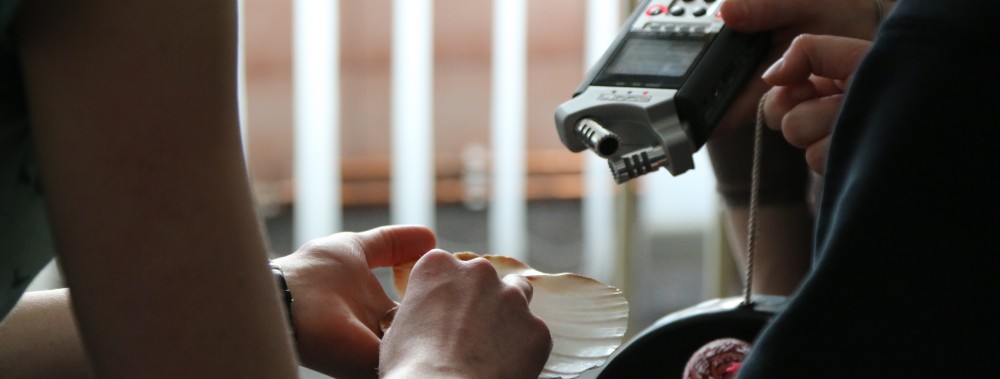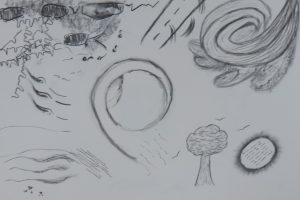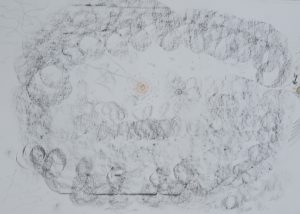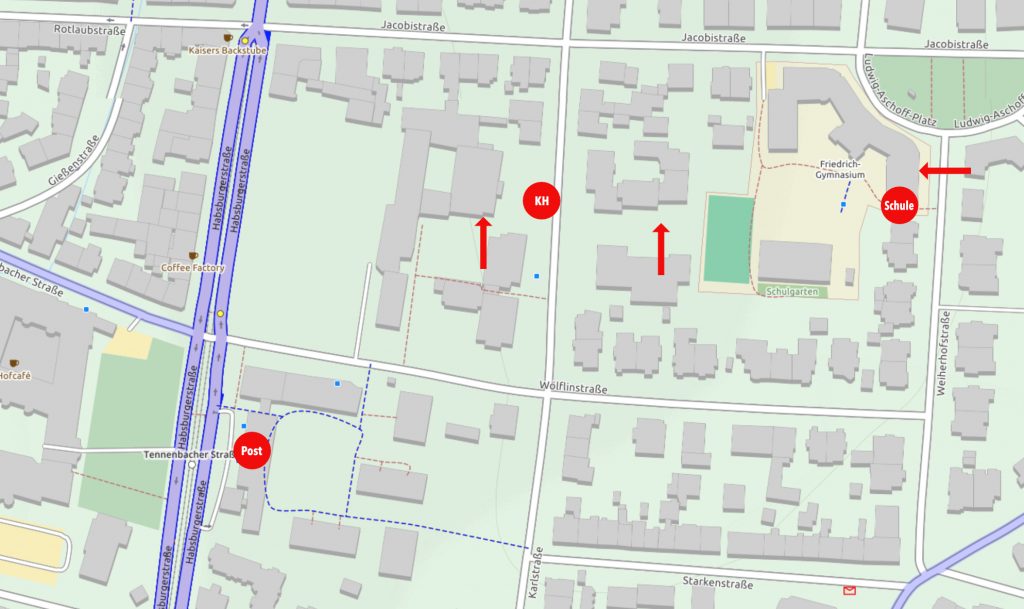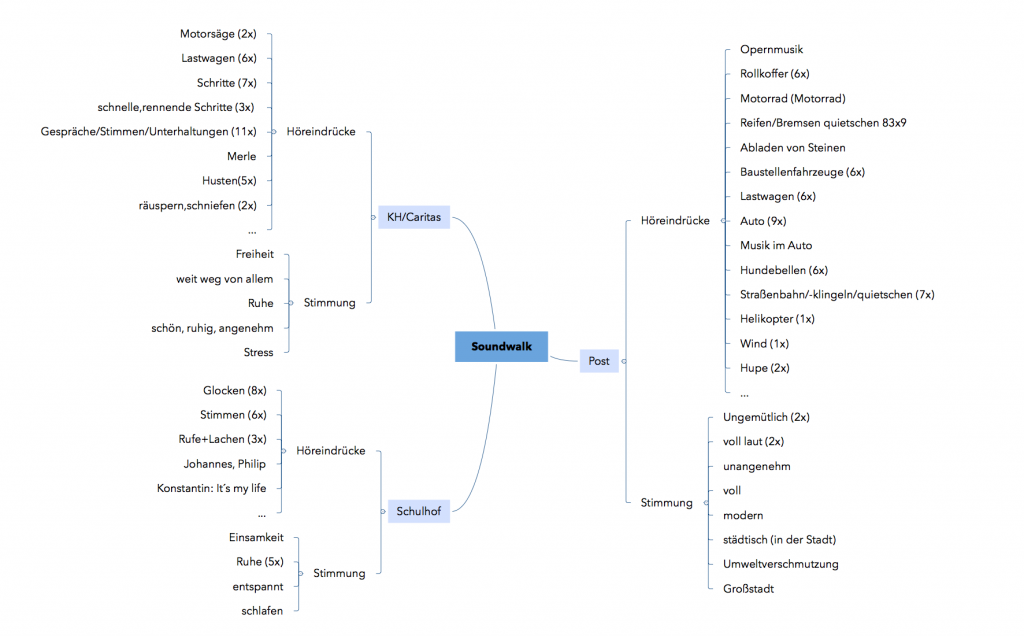Summary
The objective is to encourage a culture of hearing and listening as the basis for the subsequent musical reproduction of the explored sounds, as well as for their transformation and reinterpretation, for example, through the transfer to instrumental or vocal sounds. This module section provides the impulse for conducting a listening walk. With the entire class or in individual groups, pupils explore three stations in the vicinity of the school through listening. The stations are selected in such a way that they enable different listening experiences. In the project example, the three stations were:
- Station 1: schoolyard
- Station 2: busy intersection with a construction site and a tram stop
- Station 3: student residence with a cafeteria
Teachers should carefully adapt the stations to the individual situation, so that a diverse range of experiences can be ensured.
Duration: 2 x 90 min
Key words creativity & entrepreneurship: Enthusiasm, Interaction with the environment, Development of ideas and solutions.
Description
Step 1: Listening exercises – spatial perception – experiencing silence
Pupils sit comfortably and close their eyes. Following verbal prompts of the teacher, pupils perceive all sounds that can be heard
- within the body,
- in the room,
- outside the room.
Pupils try to translate what they hear into a picture.
Step 2: Body sounds
Pupils stand in a circle. Together, they gather different possibilities of body sounds:
Activity space 1: Sounds produced by the feet against the floor as a playing surface.
- All players start with a given foot sound, for example, stamping feet
- If one player changes the foot sound, all others react with the imitation of this sound
- The sequence is repeated until approximately 10 different foot sounds have been explored
Activity space 2: The hands play the body as a playing surface
- All players play different parts of the body with the hands / fingers and try to create sounds that are as diverse as possible
- Selected pupils improvise with the different sounds, all other players try to play along synchronously
Activity space 3: Sounds that are produced only by hands or fingers – (clapping, finger snapping, rubbing hands together…..)
- One pupil introduces a hand sound which is reproduced by all players
- Going around in the circle, the next pupil plays a new hand sound which is again copied by everyone
- Repeat until all players have played a hand / finger sound
No sound should be played twice. If, for example, a pupil claps their hands, this sound must not be repeated by another pupil in the circle.
Activity space 4: Sounds of the mouth parts – percussive sounds such as popping with the mouth, tongue clicking; air sounds such as puffing, blowing, breathing….; voiceless sounds such as consonants…
- Proceed as in activity space 3, except in the opposite direction of the circle.
Step 3: Hearing and associating body sounds
Pupils sit in a circle, two to three pupils sit in the middle, with their backs facing each other. Their eyes are closed.
- The instructor or a pupil give an impulse by introducing a body sound (clapping hands, snapping fingers, drumming on the thighs etc.) which all in the circle repeat one after another as fast as possible. The sound changes in each round with the person providing the impulse, resulting in a continuous chain reaction formed of different body sounds – (similar to the chain reaction of falling dominoes).
- Option 1: on hand sign 1, the body sounds are played one after the other, on hand sign 2, by everyone at the same time.
- Option 2: Pupils play in three groups in any order, each with a previously determined group sound.
The pupils sitting in the centre of the circle describe the ideas, associations, and spaces / landscapes, which formed during listening.
Depending on the needs of the pupils, the listening exercise is performed multiple times, or on a more regular basis as a ritual.
Step 4: Listening walk
The instructor explains to pupils the listening walk which includes three listening stations in the vicinity of the school:
- pupils should not speak at the listening stations in order to be able to fully focus on listening
- while moving on to the next listening station, talking should be kept to a minimum
- for each listening station, pupils receive cards prepared by the instructor and write down one listening impression per card. Not the object that produces the noise (e.g. car) should be noted, but the noise itself (e.g. squealing brakes, the metallic rattle of a key ring, the howling engine of a car ….)
- one pupil is selected to make digital audio recordings and should receive technical instructions in advance.
Listening walk: Pupils go to listening station 1 with the teacher and listen silently for 2-3 minutes to the noises of the environment. On the cards they brought along, pupils write down their listening impressions individually. During the listening time, all noises are recorded via the external microphone of an audio recorder. The same procedure is then repeated at listening stations 2 and 3. Finally, all go back to the classroom.
Step 5: Reflection
SuS put together a sound map with the cards. Duplicates are put on top of each other.
Reflection on the listening walk:
-
- What did we hear?
- What sounds did you like most / least?
- Were there any surprising, unusual, very particular sounds?
- What sounds were particularly loud / soft / high / low / long / short?
- Were there any sounds that moved?
- Were there sounds that changed direction multiple times?
- Which of the sounds can you sing?
- Did any of the sounds have a rhythm or a melody that can be reproduced?
Afterwards, pupils listen to the audio recordings of each station to allow them to compare their individual perception with the recorded soundscape and describe possible differences.
Step 6: Reproduction of the listening impressions with body sounds
Small groups of 4 – 6 pupils are formed. Each group member selects 1 – 2 cards from the sound map.
Group assignment:
- Try out different ways in which the noises noted on the cards can be reproduced with the voice or with body sounds.
- In the group, agree on a sequence and form a musical score (notation) by placing the cards from the left to the right. Putting several cards on top of each other creates polyphony, whereby all sounds must be played at the same time.
- Decide who plays which sound and when.
- Repeat your sequence several times until you feel confident with it.
- Give your sound composition (soundscape) a title.
Step 7: Presentation of group results in class
Variants
Listening walk with closed eyes: A very intensive form of listening can be experienced when walking with the eyes closed. For this option, pupils work in pairs. Pupil A closes their eyes and is led by pupil B across a defined area for an agreed period of time. Afterwards, they switch roles. This option requires a high level of physical competence, concentration, a strong sense of responsibility, and trust.
As an alternative to writing down the listening experiences, they may also be illustrated graphically or pictorially with pens. The resulting sound cards can then be placed together to form a sound track. The re-transfer of the sound cards into audible sounds is more direct, the musical information is more visible and can therefore be realised with far fewer requirements than the option based on written terms. This form is interesting in the interdisciplinary context with visual arts because it allows pupils to experience the connection of visual and audible perception.
Competencies
The pupils are able to:
- consciously distinguish between different listening spaces.
- listen closely to sounds of the environment over an agreed period of time.
- verbalise and reflect on listening impressions, and they compare them with each other.
- recognise rhythmic patterns and melodic motifs in everyday sounds.
- recreate listening experiences with their voices and with body sounds.
In addition, for listening walks with closed eyes the pupils are able to:
- understand tactile impulses and react in movement.
- take responsibility for other pupils and lead them carefully.
Materials
- blank cards in A6 format, preferably in different colours, i.e. one for each station
- pens
- signs with the title of each listening station for the soundmap
- recording device with external microphone
- music system to play the audio recordings
Module overview
|
|
